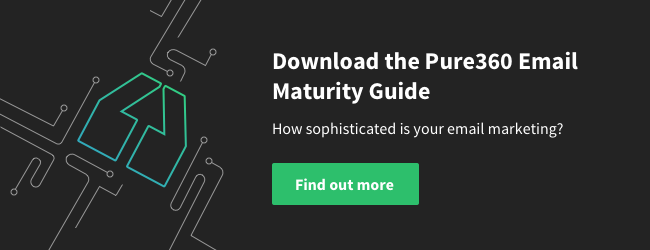There are multiple tactics that can be used in email marketing. Often they evolve as you gain experience, resource and insight into your audience.
To help you enhance your strategy we developed the Pure360 Email Maturity Model. This is an industry-leading framework of email sophistication that enables you to pinpoint how advanced you are compared to others and identify what your own short-term and long-term goals in email marketing should be.
In the following post we describe how email marketing strategies evolve and look at the types of email marketer we commonly see.
The Broadcaster
When people first start email marketing they often create one message to send to everyone on their database. This is known as a broadcast and is a quick way of getting email content out of the door with minimal effort.
The habitual use of broadcast email marketing is often the case when you only have basic databases and minimal resources to work with. Groupon are a good example of a broadcast approach to email marketing, sending all customers alerts of the same time-sensitive offers. It’s quick and easy but it won’t engage all of your audience, as one message won’t be relevant to everyone’s interests, motivations or previous activity.
The Segmenter
To move on you need to learn how to segment your data, which allows you to target groups of recipients with similar interests, demographics or behaviours. Relevant email marketing creates 18 times more revenue than broadcast campaigns (Jupiter Research). If you group certain recipients together you can create campaigns targeted at their shared interests. You’ll be spending more time producing your email marketing but as each campaign will generate more revenue, you won’t need to send so many emails overall. Lastminute.com do a good job of segmenting their customer base, sending people content based on which destinations, hotels and cities they’ve shown an interest in previously.
The Recommender
Once you’ve mastered email segmentation, the next step is getting the customer to engage with items or services which they’ve not considered before. This is when you look at recommending products, services or content to your audience in an attempt to cross-sell and upsell.
At this stage of email marketing the communications may seem more like a one-to-one dialogue than sending one message to thousands of people. There is a range of increasingly sophisticated email marketing technologies available such as PureTargeting which allows you to create recommendations based on previous purchases, trends or online behaviours. Ebay are renowned for sending recommendations of potential purchases to their subscribers based on their previous purchases and browsing activity.
The Predictor
After you’ve used all available data to make recommendations, the next step is to start pre-empting behavior by predicting it. This is when you use more sophisticated email marketing technology such as PureIntelligence to identify trends in the recipient’s behaviours to suggest purchases or interests. At this stage, you’ll often benefit from integrated database and CRM systems allowing you to deliver automated email marketing based on insights into your customer’s behaviours. Most consumers will be familiar with this type of tactic from the likes of Amazon who are famous for their ‘people who liked this also liked…’ approach to customer communications.
These four stages of email marketing are commonly seen in the industry. How far or fast you move from one to the next is often dependent on your business constraints.
If you find yourself at the more basic level of email marketing then it might be time to review how you measure the success of your email marketing, so you can progress. Moving on from only driving short term sales to developing a CRM approach that retains as well as acquires customers is often the key to progression.
And of course there’s a range of increasingly sophisticated technology solutions that enable you to develop their email marketing strategy. These technologies help you target, track, automate and segment your email marketing with minimum effort. At a basic level they help get campaigns out of the door and report the results – at a more advanced level they help you gain a better insight of their customer’s behaviour, identifying trends and enabling you to create sophisticated data models.
Whatever stage of email marketing you’re at there will be a solution to make your life easier by improving the efficiency, targeting and insight gained from your email marketing.

